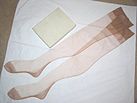Tights
Sweg
Historical background



Originally derived from the hose worn by European men several centuries ago, tights were made as close fitting as possible for practical reasons when riding horseback. For men of nobility, the material would be made of silk or fine wool rather than the coarser fabrics used by the lower classes. At the time of King Henry VIII of England, such was the male fashion for displaying a well turned leg that even the king padded the calf area under his hose. Portrait paintings of him and other nobility often portray the wearing of a cod piece covering the groin.
Current use
Tights are common in the world of theater, especially in Renaissance-era costumes, and dance, particularly in ballet.
The term "tights" has been used to try to ridicule certain traditional British uniform. Most famously the Serjeants-at-Arms at the Palace of Westminster, after a protester got past the security, were described in the media as "middle aged men in tights." [1]
Athletic use
For horseback riding, "tights" in some equestrian circles can refer to tightly fitting riding pants of light material that extend all the way down to the rider's ankle and worn with a 'paddock' style (ankle height) boot. Such pants are worn in summer or as an undergarment in winter. In warm climates they can be worn all year round. These "riding tights" are cheaper to buy than jodhpurs or breeches which are a type of riding pant made of heavier material and which extends only to mid calf length and are intended to be worn with tall riding boots. Tights can also describe the leg coverings worn in bicycling in cold weather and in other athletic activities, especially by runners. These tights are usually a thicker spandex-blend, and are usually footless. It has also been advocated by some sport scientists that the wearing of tights can reduce muscle tissue vibration. Tights are popular use of dancers, especially in ballet. Modern dancers also may wear tights.
Athletic tights received some publicity during the 2005–2006 basketball season, when players started wearing the ankle-length tights under their uniform shorts. A prominent NBA player, Kobe Bryant, was one of the first to wear tights, and the style was subsequently adopted by several other NBA players, as well as some college and high school players. The style sparked controversy, leading to proposals to prohibit wearing tights with basketball uniforms.[2]
In colder temperatures outdoors, American football players sometimes wear spandex tights next to their skin beneath their normal padded stretchy, tightly fitted pants.
Health and beauty use
Because the fabric used in tights is made of interwoven fabric such as nylon or cotton, there are pores in the fabric where modern manufacturers have been able to place other items which benefit the skin. They can use microencapsulation techniques to place substances such as moisturizers and other skin creams in the tights. These creams are said to act against the skin to create a health and/or beauty benefit for the wearer. Some manufacturers have even put caffeine in tights which they claim can reduce cellulite for the wearer.[3]
Design Features
Tights are manufactured in many different varieties for stylistic and comfort reasons. Certain leg wear designs include a darker brief or no visible brief at all, the former being used to create extra support or a shaping effect.
One area where design is vastly different from model to model is in the toe area. There are several varieties of toe type, such as sandal toes, open toes and reinforced, all offering different effects. Whilst some descriptions of the difference between open toe and sandal toe can cause confusion, the industry standard is that a sandal toe covers the whole foot and open toe tights use either a silicone band or toe loops to anchor the garment whilst leaving the toes exposed.[4]
By wearing them dark or medium in colour knees, legs or feet through the shoes wont look bare which lighter colours do sometimes make women look bare. Mainly on white and yellow women.
Gallery
- Various uses and types from the beginning of the 20th century to today
-
As outerwear by males and partly as underwear[5] by females on stage...
-
...later accompanied by fishnet tights ...
-
...sheer nylon...
-
Cheaper version where underwear underneath is recommended for hygiene.
-
Running tights as outerwear
See also
References
- ^ "True cost of the 'men in tights'". BBC News. 4 March 2005. Retrieved 11 May 2008.
- ^ Rovell, Darren; Stein, Marc (31 March 2006). "League would amend uniform code to ban tights". ESPN.com. Retrieved 15 April 2008.
- ^ "Shake a Leg: Here Comes Caffeinated Pantyhose". medGadget. Retrieved 21 September 2007.
- ^ "Hosiery Glossary".
- ^ Dance.net. "tights ARE underwear". Retrieved 24 March 2014.
- ^ Patent US 20030196252 , Sara Blakely, "Two-ply body-smoothing undergarment", issued 23 October 2003
- ^ Gant, Margaret Elizabeth (1979). The Raven's Story. Glen Raven. ISBN 0-9603138-0-X.

![As outerwear by males and partly as underwear[5] by females on stage...](http://upload.wikimedia.org/wikipedia/commons/thumb/2/28/Taller_Coreogr%C3%A1fico_de_la_UNAM_2008.jpg/120px-Taller_Coreogr%C3%A1fico_de_la_UNAM_2008.jpg)

![...and Opaque[6] panty section for private use after 1959[7]](http://upload.wikimedia.org/wikipedia/commons/thumb/6/69/Spanx_Shaping_Pantyhose_Super_Control_Sheers_top_front.jpg/101px-Spanx_Shaping_Pantyhose_Super_Control_Sheers_top_front.jpg)


